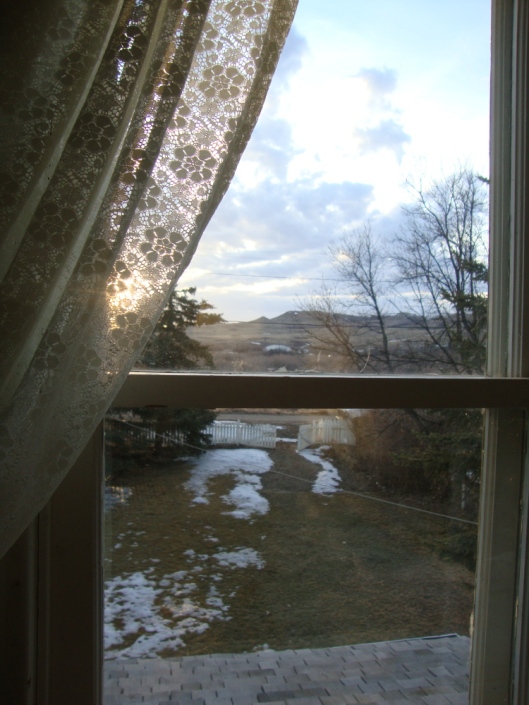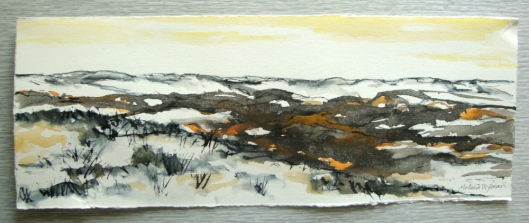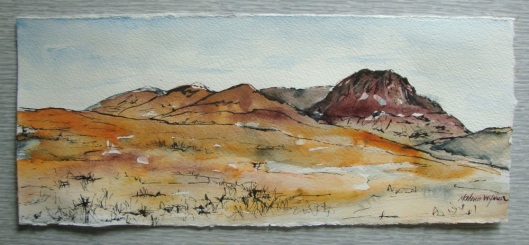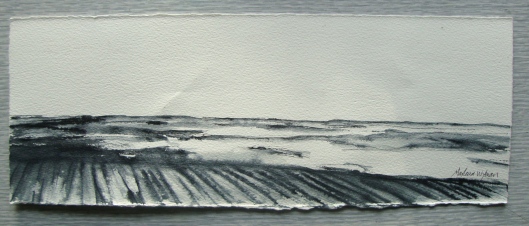Tags
Chocolate Peak, Eastend Saskatchewan, Frenchman River Valley, Frontier Saskatchewan, ink drawings, landscape, prairie, Sharon Butala, T. rex Discovery Centre, The Perfection of the Morning, Wallace Stegner, Wallace Stegner House, watercolour paintings, Wolf Willow
In Sharon Butala’s book The Perfection of the Morning: An Apprenticeship in Nature, the Saskatchewan prairie landscape is a place of constant exploration for her. “The Great Plains landscape is an elemental one…It is geology stripped bare, leaving behind only a vast sky and land stretched out in long, sweeping lines that blend into the distant horizon…”
The study/studio where I draw and paint is on west side of the Wallace Stegner house, and looks out over the Frenchman River and the hills beyond. The house is on the edge of the town of Eastend, and the view just beyond the civilized white picket fence of the back yard is one of the natural landscape. A short walk takes me farther into that landscape and a drive farther yet. It makes me realize that it has not been since my childhood that I have lived in such close contact with the land.
 View from the window of the Wallace Stegner House study/studio.
View from the window of the Wallace Stegner House study/studio.
I have taken advantage of that presence of the landscape and early spring’s warm weather to explore the surrounding countryside over the last couple of days. The land closest to Eastend is patterned with dry grassland, hills and coulees. It reminds me of the badlands of Drumheller near the farm where I grew up. The T. Rex Discovery Centre here holds the largest and most complete Canadian Tyrannosaurus Rex skeleton, which was found in the nearby hills.
 One of my watercolour paintings of the land in the Frenchman River Valley.
One of my watercolour paintings of the land in the Frenchman River Valley.
One of the topographical attractions just outside Eastend is Chocolate Peak. According to the story, the hill was originally known as Wedding Cake Hill, with a large deposit of whitemud clay at its base with a seam of coal above the clay. A whitemud miner set fire to the coal to gain easier access to the clay. The coal burned in the hill for years, baking the clay and ruining the deposit. The white clay turned dark brown and Wedding Cake Hill was renamed Chocolate Peak.
 My watercolour painting of Chocolate Peak.
My watercolour painting of Chocolate Peak.
As I drove further south toward the nearby town of Frontier, close to the U.S. border, the land flattened out and the view enlarged. This is the idiosyncratic Saskatchewan landscape.
In Wallace Stegner’s book Wolf Willow: A History, a Story and a Memory of the Last Plains Frontier, the Saskatchewan prairie landscape dominates many memories of his youth, his history of the land, and his stories of the early pioneers. “The world is very large, the sky even larger, and you are very small. But also the world is flat, empty, nearly abstract, and in its flatness you are a challenging upright thing, as sudden as an exclamation mark, as enigmatic as a question mark.”
 My ink sketch of the land near Frontier, Saskatchewan.
My ink sketch of the land near Frontier, Saskatchewan.
Posted by Marlena Wyman

NIce landscapes Marlena…early spring is so inspiring. Keep up the good work!
Thanks Danielle. It is very inspiring here indeed. I hope the Women’s Art Museum event was a success back home!
It was not bad for our first one and Erin got some experience. The goodies were great!
The watercolours and sketch transport me to my time growing up in the south and watching spring emerge on the prairie.
This landscape brings me back to my youth on the Alberta prairies too, Ron. No buds or spring green yet but it feels like they will appear soon. Hopefully before I head back home!
I love the story of Chocolate Peak 🙂 thank you for continuing to share your journey!
There is so much beauty in the Prairie landscape. Have you found a crocus by chance? I remember how exciting it was to take a walk at the farm and find a crocus poking thru the snow.
No crocuses sighted yet. I am keeping watch.